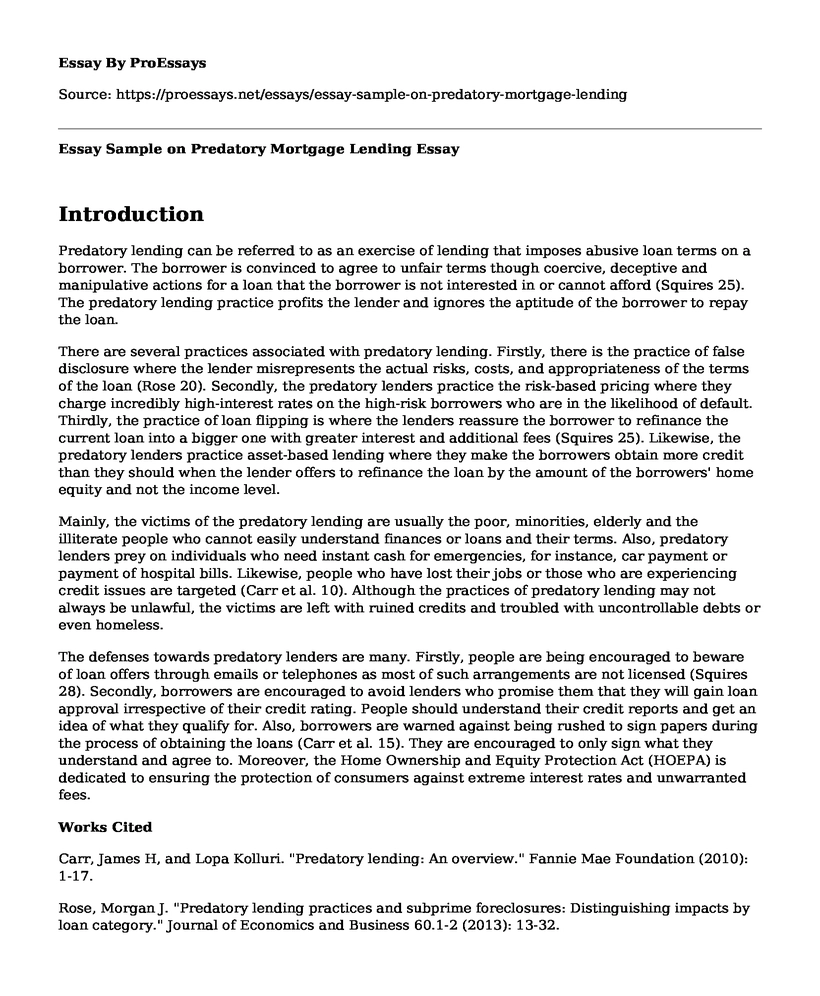Introduction
Predatory lending can be referred to as an exercise of lending that imposes abusive loan terms on a borrower. The borrower is convinced to agree to unfair terms though coercive, deceptive and manipulative actions for a loan that the borrower is not interested in or cannot afford (Squires 25). The predatory lending practice profits the lender and ignores the aptitude of the borrower to repay the loan.
There are several practices associated with predatory lending. Firstly, there is the practice of false disclosure where the lender misrepresents the actual risks, costs, and appropriateness of the terms of the loan (Rose 20). Secondly, the predatory lenders practice the risk-based pricing where they charge incredibly high-interest rates on the high-risk borrowers who are in the likelihood of default. Thirdly, the practice of loan flipping is where the lenders reassure the borrower to refinance the current loan into a bigger one with greater interest and additional fees (Squires 25). Likewise, the predatory lenders practice asset-based lending where they make the borrowers obtain more credit than they should when the lender offers to refinance the loan by the amount of the borrowers' home equity and not the income level.
Mainly, the victims of the predatory lending are usually the poor, minorities, elderly and the illiterate people who cannot easily understand finances or loans and their terms. Also, predatory lenders prey on individuals who need instant cash for emergencies, for instance, car payment or payment of hospital bills. Likewise, people who have lost their jobs or those who are experiencing credit issues are targeted (Carr et al. 10). Although the practices of predatory lending may not always be unlawful, the victims are left with ruined credits and troubled with uncontrollable debts or even homeless.
The defenses towards predatory lenders are many. Firstly, people are being encouraged to beware of loan offers through emails or telephones as most of such arrangements are not licensed (Squires 28). Secondly, borrowers are encouraged to avoid lenders who promise them that they will gain loan approval irrespective of their credit rating. People should understand their credit reports and get an idea of what they qualify for. Also, borrowers are warned against being rushed to sign papers during the process of obtaining the loans (Carr et al. 15). They are encouraged to only sign what they understand and agree to. Moreover, the Home Ownership and Equity Protection Act (HOEPA) is dedicated to ensuring the protection of consumers against extreme interest rates and unwarranted fees.
Works Cited
Carr, James H, and Lopa Kolluri. "Predatory lending: An overview." Fannie Mae Foundation (2010): 1-17.
Rose, Morgan J. "Predatory lending practices and subprime foreclosures: Distinguishing impacts by loan category." Journal of Economics and Business 60.1-2 (2013): 13-32.
Squires, Gregory D. Why the poor pay more: How to stop predatory lending. Greenwood Publishing Group ( 2009): 18-30
Cite this page
Essay Sample on Predatory Mortgage Lending. (2022, Nov 24). Retrieved from https://proessays.net/essays/essay-sample-on-predatory-mortgage-lending
If you are the original author of this essay and no longer wish to have it published on the ProEssays website, please click below to request its removal:
- Essay Sample on Diversified Investment Portfolio
- The Budgeting and Financial Planning Approach for A2 Milk Company
- Health Insurance in the US Essay Example
- A Discussion on the History and Current Issues Related to Personal Income Tax
- The Blue Cross Blue Shield of Massachusetts Scenario Planning Process Paper Example
- Essay on KitchDirec: Eliminating Intermediaries to Lower Cost of Kitchen Wares
- Paper on Project Control and Cost Analysis







